
The Twelfth Air Force (12 AF; Air Forces Southern, (AFSOUTH)) is a Numbered Air Force of the United States Air Force Air Combat Command (ACC). It is headquartered at Davis–Monthan Air Force Base, Arizona.
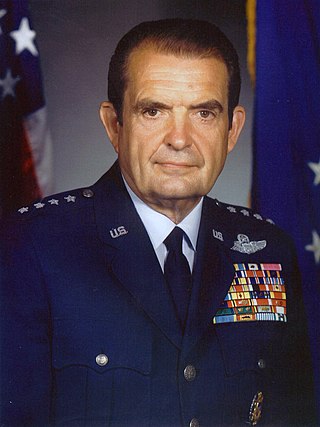
David Charles Jones was a United States Air Force general and the ninth chairman of the Joint Chiefs of Staff. In this capacity, Jones served as the highest-ranking uniformed officer of the United States Armed Forces. He previously served as the ninth Chief of Staff of the United States Air Force and fifteenth commander of the United States Air Forces in Europe.
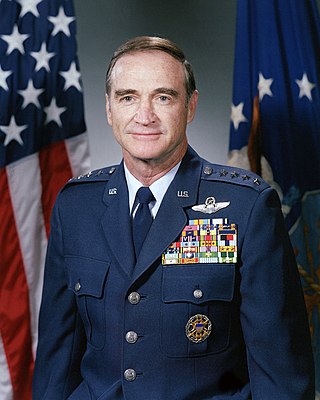
Charles Alvin Gabriel was the 11th Chief of Staff of the United States Air Force. As chief of staff, Gabriel served in a dual capacity. He was a member of the Joint Chiefs of Staff which, as a body, acts as the principal military adviser to the president, the National Security Council, and the Secretary of Defense. In his other capacity, he was responsible to the Secretary of the Air Force for managing the vast human and materiel resources of the world's most powerful aerospace force.

Joseph William Ashy, is a retired United States Air Force (USAF) general who was commander in chief of North American Aerospace Defense Command and United States Space Command, and commander of Air Force Space Command, headquartered at Peterson Air Force Base, Colorado. As commander of NORAD, General Ashy was responsible for the air sovereignty of the United States and Canada, as well as for providing tactical warning and attack assessment. As USCINCSPACE, he commanded the unified command responsible for directing space control and support operations including theater missile defense. As COMAFSPC, he directed satellite control, warning, space launch and ballistic missile operations missions through a worldwide network of support facilities and bases.
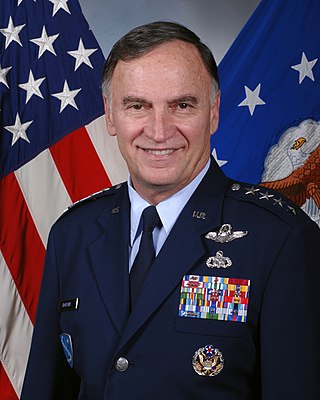
William Thomas Hobbins is a former Air Force general, commander of U.S. Air Forces Europe; commander of Air Component Command, Ramstein; and director of Joint Air Power Competence Center, Kalkar, Germany.

William Wallace Momyer was a general officer and fighter pilot in the United States Air Force (USAF). Among his notable posts were those commanding Air Training Command, the Seventh Air Force during the Vietnam War, and Tactical Air Command (TAC). During his tour in Southeast Asia, he was concurrently the deputy commander of Military Assistance Command, Vietnam (MACV) for air operations and thus responsible for Operation Rolling Thunder, the air campaign against North Vietnam, which Momyer executed in the face of micromanagement from President Lyndon B. Johnson and Secretary of Defense Robert S. McNamara.

General Benjamin Wiley Chidlaw was an officer in the United States Air Force. He directed the development of the United States' original jet engine and jet aircraft. He joined the United States Army Air Service, at the time a precursor to the United States Air Force (USAF), in 1922 and for several years served in training and engineering positions. By 1940 he was chief of the Experimental Engineering Branch and involved with the development of jet engines. During World War II he was deputy commander of 12th Tactical Air Command and later organised the establishment of the 22nd Tactical Air Command in the European Theater of Operations. After the war he remained in senior command positions and finished his career with the USAF in 1955 as commander in chief of the Continental Air Defense Command with the rank of general. He died in 1977 at the age of 76.

Otto Paul Weyland was a United States Air Force (USAF) general and the post-World War II Commander of Far East Air Forces during the Korean War and of Tactical Air Command.

Frank Fort Everest was a four-star general in the United States Air Force (USAF). He commanded both United States Air Forces in Europe and Tactical Air Command.

General Gabriel Poillon Disosway was a noted four-star general in the United States Air Force (USAF) and served as commander of Tactical Air Command.

General Robert Merrill Lee CBE was the air deputy to the Supreme Allied Commander Europe, with the responsibility of assisting SACEUR in developing, training and employing NATO combat forces for the defense of allied Europe.
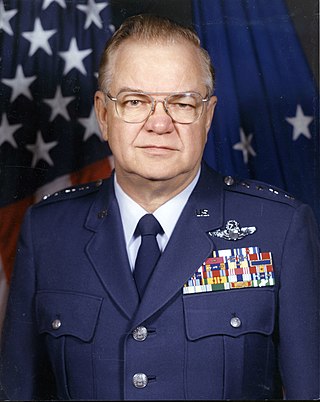
William Leslie Kirk was a four-star general in the United States Air Force (USAF). He served as Commander in Chief, United States Air Forces in Europe/Commander, Allied Air Forces Central Europe (CINCUSAFE/COMAAFCE) from 1987 to 1989.

Frederic Harrison Smith Jr. was a United States Air Force four-star general who served as Commander in Chief, U.S. Air Forces in Europe (CINCUSAFE) from 1959 to 1961; and Vice Chief of Staff, U.S. Air Force (VCSAF) from 1961 to 1962.

Roger Alan Brady is a former United States Air Force (USAF) four-star general who last served as the 33rd Commander, U.S. Air Forces in Europe (USAFE) which he also concurrently served as commander of NATO Allied Air Command, Ramstein Air Base, Germany and director of Joint Air Power Competence Center, Kalkar, Germany from January 9, 2008, to December 13, 2010. Prior to that he served as deputy chief of staff for manpower and personnel from June 2004 to January 2008. As commander of USAFE, he has responsibility for USAF activities in the U.S. Africa Command theater.

Northwest African Air Forces (NAAF) was a component of the Allied Mediterranean Air Command (MAC) during February–December 1943. It was responsible primarily for air operations during the Tunisian Campaign and bombing of Italy. Its commander was Lieutenant General Carl Spaatz of the United States Army Air Force. NAAF was created following a reorganization of the command structure of Allied air forces in the Mediterranean Theatre. The other components of MAC were Middle East Command (MEC), AHQ Malta, RAF Gibraltar and 216 Group.

The Mediterranean Allied Air Forces (MAAF) was the major Allied air force command organization in the Mediterranean theater from mid-December 1943 until the end of the Second World War.
The Northwest African Training Command (NATC) was a sub-command of the Northwest African Air Forces (NAAF) which itself was a sub-command of the Mediterranean Air Command (MAC). These new Allied air force organizations were created at the Casablanca Conference in January 1943 to promote cooperation between the British Royal Air Force (RAF), the American United States Army Air Force (USAAF), and their respective ground and naval forces in the North African and Mediterranean Theater of Operations (MTO). Effective February 18, 1943, the NATC and other MAC commands existed until December 10, 1943 when MAC was disbanded and the Mediterranean Allied Air Forces (MAAF) were established.
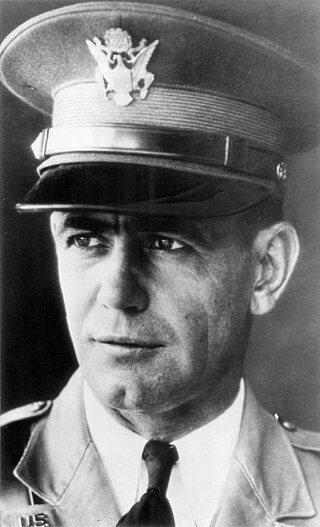
Harold Huston George was a general officer in the United States Army Air Forces during World War II. He began his military career before World War I when he enlisted as a private in the 3rd New York Infantry Regiment. Joining the Air Service, he became an ace in France in 1918, credited with five aerial victories.

Ralph Royce was a United States Army Air Forces general during World War II. A West Point graduate who learned to fly in 1915–16, he served with the 1st Aero Squadron in the Pancho Villa Expedition and later led it on the Western Front. During World War II as a brigadier general, he led the Royce special mission to Mindanao, in which a small force of bombers flew from Australia to attack Japanese targets in the Philippines. Later he was Deputy Commander of the Ninth Air Force and commanded the 1st Provisional Tactical Air Force.
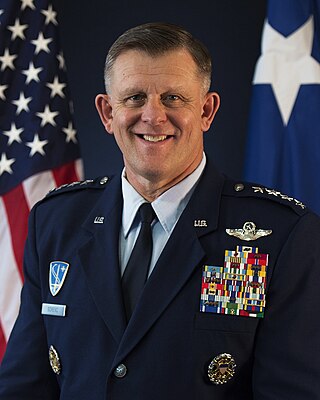
Frank Gorenc is a retired United States Air Force four-star general who served as the Commander, United States Air Forces in Europe – Air Forces Africa and Commander, Allied Air Command. He previously served as the Assistant Vice Chief of Staff and Director, Air Staff, Headquarters, United States Air Force at the Pentagon. Gorenc is a command pilot with more than 4,100 flight hours in the T-38A, F-15C, MQ-1B, UH-1N and C-21A. He assumed his final assignment on 2 August 2013.






















